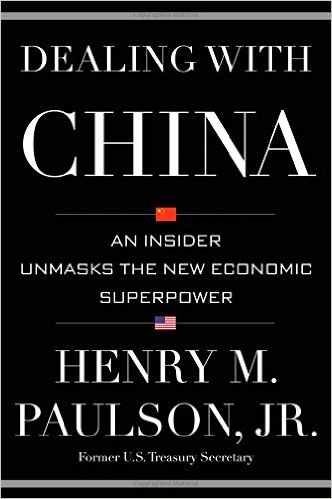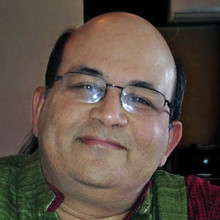[Photograph by Global Jet under Creative Commons]
Ever since India embarked on the path of economic liberalization, we have been in awe of China and keen to emulate its impressive growth. Comparisons between India and China are common. So is the lament that "we can't be like them" every time we see a huge gap between the two countries on any parameter. The reason attributed to these gaps is also a standard one - our democratic process prevents coherent decision making and implementation while China can take decisions and implement them top-down almost at the click of a finger.
I have always been very sceptical of this caricature. No country can be a monolith, much less a country of China's size and diversity. Yes, there is a single Communist Party with control over the government and the military, but in a country of more than a billion people, the Communist Party can't govern effectively without at least some degree of public support. And there must be different voices within the Party, with different views, and some internal marketplace where these ideas play out. Given the large geographical size of the country, the farther away a province is from Beijing, the more it may be tempted to try a few things on its own. Henry "Hank" Paulson's new book Dealing with China: An Insider Unmasks the New Economic Superpower (Hachette, 2015) corroborates many of these hunches.
No country can be a monolith, much less a country of China’s size and diversity.
Hank Paulson's New Book

Paulson is well known to the world as the US treasury secretary at the time of the 2007-08 financial crisis. Prior to that, he held senior positions, including that of chief executive officer (CEO) at Goldman Sachs. Since the early 1990s, Paulson has visited China more than a hundred times and has known multiple generations of Chinese leaders including the current leader Xi Jinping. He led the American side at the pioneering Strategic Economic Dialog with China that was started by President George W Bush.
At a broad level, Paulson may not add much to what the avid China watcher already knows. But his book is a comprehensive and eminently readable account of the economic challenges, political structure, and strategic concerns of China at this time. His personal access to the top Chinese leadership lends a degree of authenticity that other accounts can’t claim, besides giving a close-up look at their individual thought processes.
Here are some features of China described in Paulson's book that I found particularly interesting.
People Management
There is no distinction between the political executive and the bureaucracy in the sense that all of them belong to the Communist Party. You can’t be a senior official unless you are a Party member. There is no equivalent of "lateral hiring". The Party seems to manage the careers of high performers very effectively (large corporations could learn a thing or two from this, though I am not sure how much is known about the details of the process the Party follows), rotating them through different roles to prepare them for higher office. One of the important roles where people get a chance to demonstrate their talent is as mayor of a city or province, a kind of mini-CEO if you will. Almost all top Chinese leaders have held mayoral positions at some time or the other.
One of the important roles where people get a chance to demonstrate their talent is as mayor of a city or province
Though relationships and loyalties matter, there is a strong performance management system at work. Over the last three decades, there was a strong alignment between goals and incentives, with a single, simple, measurable goal, i.e., economic growth. Of course, such an undiluted emphasis on growth has led to other problems such as over investment in infrastructure, an overhang of debt, environmental degradation and corruption, but growth happened!
Paulson notes that Chinese leaders do their homework - they are well-prepared, take extensive notes during meetings, and then read the notes taken by themselves and relevant others before the next meeting. He also observes that they are very practical - he found a top leader, Zhu Rongji, wearing inners (peeping out through the bottom of his trousers) to guard against the cold, not depending on the heating system!
Policy and the Economy
The Communist Party under Deng Xiaoping justified the shift away from communism to "Socialism with Chinese characteristics" through a promise of economic prosperity which has to a large extent been realized. However, another non-negotiable part of the deal is the continuing political monopoly of the Party. As growth rates slow and China turns to cleaning up the externalities arising from rapid growth, we can expect to see the country flexing its muscles in the international arena.
A question that has always intrigued me is how has China managed to invest so much internally (e.g. in infrastructure) and all over the world (look at its investments in Africa, for instance) without getting into a huge fiscal mess? Contrast this with India and the huge budgetary cuts we have seen in essential sectors like education and health as we seek to achieve the fiscal responsibility target. It turns out that China's finances are not all that hunky dory. The state-owned banks have huge bad debts from loans made to state-owned enterprises (SOEs). China has seen ups and downs, including bouts of inflation, but these have been managed well. Like India, China's domestic debt market is not well developed.
China has no visible safety net though publicly-provided education and healthcare work well. One traditional form of support - the "Iron rice bowl" based on lifelong employment in SOEs - has come apart in recent years as China has tried to make the SOEs more productive and efficient, and hence downsized many of them.
There is an ongoing tension between reformers and conservatives. The global financial meltdown gave a new lease of life to the conservatives since it brought to the fore what can go wrong in a capitalist system. It certainly slowed down financial sector reform in China, and advocates of sweeping changes like Paulson have found it much more difficult to influence the Chinese government on such issues since then. The Chinese government's discomfort with the way markets work is reflected in their ongoing, valiant efforts to arrest the sharp decline in Chinese stock markets in the last few weeks!
One thing China has in common with India is inheritance of power. Sons and daughters of influential members of the Party - called "princelings" - appear to go up the hierarchy faster. Many of them have also been involved in setting up new enterprises that have grown rapidly in tandem with the country's growth and have become very rich in the process.
One thing China has in common with India is inheritance of power.
China is well known for its pragmatism, starting from Deng's memorable comment about how the colour of the cat doesn't matter as long as it catches the mouse. I particularly liked a comment cited by Paulson: "Chinese learning as a base, Western learning for practical applications" (p. 18), quoting Zhang Zhidong, a 19th century Qing Dynasty official. In a short time, the Chinese have shown themselves to be adept at absorbing a lot from the West. But the big test comes now as China seeks to move to higher levels of value addition through innovation and technology development.
The big test comes now as China seeks to move to higher levels of value addition.
One prominent feature of China's reforms has been the renaissance of the Chinese university system. Considering that under the Cultural Revolution the higher education system was almost dismantled, the fact that some Chinese universities are today among the top 100 in the world is testimony to the importance given by the Chinese leadership to education. Another reflection of this is provided by Paulson - thanks to his proximity to senior Chinese leaders, he got roped into the upgradation of the Business School at Tsinghua University. He co-chaired an International Advisory Board that spearheaded a collaboration with Harvard Business School to make the curriculum more practical, using Harvard’s case study-based participant-centered learning approach. This was initiated by former Chinese Premier Zhu Rongji, himself a Tsinghua alum.
Takeaways for India
Practices from one country don't always transfer well to another due to cultural, political and social differences. India is, of course, very different from China. So, it obviously doesn’t make sense to blindly ape what that country is doing. Yet, at the level of broad principles, I see a few takeaways from Paulson’s account of China.
India would definitely benefit from a more robust performance management system for the bureaucracy with clear definition of goals, measurement of results and postings based on performance. To enable this to work, bureaucrats must be given a minimum, if not a fixed tenure in each role. The outcomes of their work should be given greater visibility. Ironically, a comprehensive performance management system was being put in place under the guidance of the cabinet secretariat but the system was never linked to rewards and postings and thus remained incomplete.
We should encourage more experimentation in policies and programmes, and then try to scale-up or replicate what works, but again with possibilities of adaptation. There is a tendency to insist on uniformity in policies and programmes across the country without allowing for such flexibility. In contrast, some of China’s most successful programmes, including the Special Economic Zones, started as experiments in different parts of the country. In this context, the policy of the present government to let states devise their own social programmes could be a positive move - my only fear would be straitjacketing within the states themselves which won’t work as many of our states are as big as some European countries!
Last but not least, it’s been clear for almost 15 years now that China is moving in to a different league altogether as far as education is concerned. China’s singular achievement has been the combination of quality and quantity. In India, we have not yet figured out how to achieve these twin objectives, with quantity continuing to dominate. Paulson does not discuss this in detail but from what I have read elsewhere, China has combined investment with incentives for outstanding performance, once again based on a clear measurement of goals and outcomes.
[The views expressed here are the personal views of the author.]

